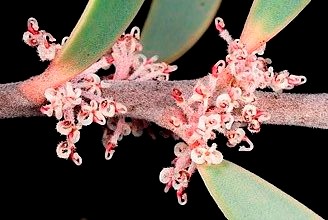Northern fan leaf
(Hakea brownii)

Description
Hakea brownii is a lignotuberous shrub growing to 0.4 to 2.5 metres (1.3 to 8.2 ft) high. Smaller branches and new leaves are densely covered in matted rusty coloured silky hairs, becoming smooth by flowering. The leaves are ornamental, fan shaped, stiff, thickly textured and prickly toothed at the apex. They have straight sides tapering to the base, 2.8–6.5 cm (1–3 in) long and 2–6 mm (0.08–0.2 in) wide. The inflorescence consists of 6-10 small sweetly scented cream-brown flowers on an obscure stem. The pedicels are 2–6 mm (0.08–0.2 in) long thickly covered in matted silky rusty coloured hairs extending onto the lower part of the flower. The perianth is 5–7 mm (0.2–0.3 in) long and the style 7–9 mm (0.3–0.4 in) long. Flowers appear in clusters in the leaf axils or on old wood from August to November. The large rounded egg-shaped fruit are 3.5–5 cm (1–2 in) long and 4–4.5 cm (2–2 in) wide. The fruit surface is wrinkled and may have a network of veins tapering to a short beak Hakea brownii was first described by Carl Meisner in 1845 and was published in Plantae Preissianae. The species was named after Robert Brown, librarian of the Linnean Society of London. Hakea brownii is widespread from the coastal plains of the Murchison River through the central wheatbelt to Cape Riche. Grows on sandy loam, deep sand or sand over laterite in heath or shrubland. Requires a well-drained site with a sunny aspect. A frost-tolerant species, having uses in floral art and wildlife habitat. Plants in the genus Hakea are shrubs or small trees. Some species have flat leaves, whilst others have leaves which are needle-like, in which case they are sometimes divided and sometimes have a groove on the lower surface. The flowers are arranged in groups in leaf axils and are surrounded by bracts when in bud. The flowers have both male and female parts and are borne on a short stalk called a pedicel. The sepals and petals, jointly called tepals, form a curved tube which sometimes splits open as the flower develops. The style is longer than the tepal tube and is curved before its tip is released. When released, the tip of the style is a pollen-presenter. The fruit of hakeas is woody and persists on the plant until burned in a bushfire or until the plant dies. The fruit then splits open to release two winged seeds.
Taxonomic tree:







